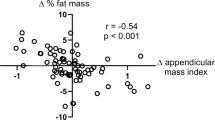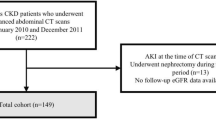Abstract
Background/Objectives:
There are few studies of the association between low appendicular muscle mass (LAM) and clinical outcomes in peritoneal dialysis (PD) patients. We aimed to determine the clinical association between LAM and clinical outcomes in PD patients.
Subject/Methods:
We reviewed all PD patients who underwent PD between January 2001 and April 2014. Each patient’s appendicular lean mass was estimated using dual-energy X-ray absorptiometry. The appendicular muscle mass index (AMI) was calculated using total appendicular lean mass (kg) over body mass index (kg/m2). The cut-off AMI value for LAM was <0.789 for men and <0.512 for women.
Results:
The number of patients in the Non-LAM and LAM groups was 328 and 303, respectively. The median follow-up durations in the Non-LAM and LAM groups were 47 and 49 months, respectively. The numbers of deaths in the Non-LAM and LAM groups were 96 (29.3%) and 160 (52.8%), respectively. In a comparison with the Non-LAM group, the hazard ratio in the LAM group was 1.74 (95% confidence interval (CI), 1.35–2.24) in univariate and 1.71 (95% CI, 1.28–2.26) in multivariate Cox regression analysis. In addition, the hazard ratio for a 0.1 increase in baseline AMI was 0.89 (95% CI, 0.84–0.95) in univariate analysis and 0.84 (95% CI, 0.76–0.91) in multivariate analysis. Analyses using the 1-year AMI showed trends similar to those for the initial AMI.
Conclusions:
Our study showed the association of LAM with mortality in the incident PD patients.
This is a preview of subscription content, access via your institution
Access options
Subscribe to this journal
Receive 12 print issues and online access
$259.00 per year
only $21.58 per issue
Buy this article
- Purchase on Springer Link
- Instant access to full article PDF
Prices may be subject to local taxes which are calculated during checkout


Similar content being viewed by others
References
US Renal Data System: USRDS 2014 Annual Data Report. National Institutes of Health, National Institute of Diabetes and Digestive and Kidney Diseases: Bethesda, MD, USA, 2014.
Shlipak MG, Fried LF, Cushman M, Manolio TA, Perterson D, Stehman-Breen C et al. Cardiovascular mortality risk in chronic kidney disease: comparison of traditional and novel risk factors. JAMA 2005; 293: 1737–1745.
Abellan van Kan G . Epidemiology and consequences of sarcopenia. J Nutr Health Aging 2009; 13: 708–712.
Visser M, Schaap LA . Consequences of sarcopenia. Clin Geriatr Med 2011; 27: 387–399.
Morley JE, Vellas B, van Kan GA, Anker SD, Bauer JM, Bemabei R et al. Frailty consensus: a call to action. J Am Med Dir Assoc 2013; 14: 392–397.
Cruz-Jentoft AJ, Baeyens JP, Bauer JM, Boirie Y, Cederholm T, Landi F et al. Sarcopenia: European consensus on definition and diagnosis—Report of the European Working Group on Sarcopenia in Older People. Age Ageing 2010; 39: 412–423.
Musso CG, Jauregui JR, Macías Núñez JF . Frailty phenotype and chronic kidney disease: a review of literature. Int Urol Nephrol 2015; 47: 1801–1807.
Cesari M, Pahor M, Lauretani F, Zamboni V, Bandinelli S, Bernabei R et al. Skeletal muscle and mortality results from the InCHIANTI Study. J Gerontol A Biol Sci Med Sci 2009; 64: 377–384.
Newman AB, Kupelian V, Visser M, Simonsick EM, Goodpaster BH, Kritchevsky SB et al. Strength, but not muscle mass, is associated with mortality in the health, aging and body composition study cohort. J Gerontol A Biol Sci Med Sci 2006; 61: 72–77.
Davies SJ, Phillips L, Naish PF, Russell GI . Quantifying comorbidity in peritoneal dialysis patients and its relationship to other predictors of survival. Nephrol Dial Transplant 2002; 17: 1085–1092.
Watson P, Watson I, Batt R . Total body water volumes for adult males and females estimated from simple anthropometric measurements. Am J Clin Nutr 1980; 33: 27–39.
Peritoneal Dialysis Adequacy Work Group. Clinical practice guideline for peritoneal dialysis adequacy. Am J Kidney Dis 2006; 48 (Suppl 1): S98–129.
Studenski SA, Peters KW, Alley DE, Cawthon PM, McLean RR, Harris TB et al. The FNIH sarcopenia project: rationale, study description, conference recommendations, and final estimates. J Gerontol A Biol Sci Med Sci 2014; 69: 547–558.
Stenvinkel P, Heimbürger O, Paultre F, Diczfalusy U, Wang T, Berglund L et al. Strong association between malnutrition, inflammation, and atherosclerosis in chronic renal failure. Kidney Int 1999; 55: 1899–1911.
Dong J, Li YJ, Lu XH, Gan HP, Zuo L, Wang HY . Correlations of lean body mass with nutritional indicators and mortality in patients on peritoneal dialysis. Kidney Int 2008; 73: 334–340.
Huang JW, Lien YC, Wu HY, Yen CJ, Pan CC, Hung TW et al. Lean body mass predicts long-term survival in Chinese patients on peritoneal dialysis. PLoS One 2013; 8: e54976.
O'Lone EL, Visser A, Finney H, Fan SL . Clinical significance of multi-frequency bioimpedance spectroscopy in peritoneal dialysis patients: independent predictor of patient survival. Nephrol Dial Transplant 2014; 29: 1430–1437.
Cawthon PM, Peters KW, Shardell MD, McLean RR, Dam TT, Kenny AM et al. Cutpoints for low appendicular lean mass that identify older adults with clinically significant weakness. J Gerontol A Biol Sci Med Sci 2014; 69: 567–575.
Cho KH, Do JY, Park JW, Yoon KW . Effect of icodextrin dialysis solution on body weight and fat accumulation over time in CAPD patients. Nephrol Dial Transplant 2010; 25: 593–599.
Bargman JM, Thorpe KE, Churchill DN,, CANUSA Peritoneal Dialysis Study Group. Relative contribution of residual renal function and peritoneal clearance to adequacy of dialysis: a reanalysis of the CANUSA study. J Am Soc Nephrol 2001; 12: 2158–2162.
Paniagua R, Amato D, Vonesh E, Correa-Rotter R, Ramos A, Moran J et al. Effects of increased peritoneal clearances on mortality rates in peritoneal dialysis: ADEMEX, a prospective, randomized, controlled trial. J Am Soc Nephrol 2002; 13: 1307–1320.
Shafi T, Jaar BG, Plantinga LC, Fink NE, Sadler JH, Parekh RS et al. Association of residual urine output with mortality, quality of life, and inflammation in incident hemodialysis patients: the Choices for Healthy Outcomes in Caring for End-Stage Renal Disease (CHOICE) study. Am J Kidney Dis 2010; 56: 348–358.
Pietrobelli A, Wang Z, Formica C, Heymsfield SB . Dual-energy X-ray absorptiometry: fat estimation errors due to variation in soft tissue hydration. Am J Physiol 1998; 274 (5 Pt 1): E808–E816.
Formica C, Atkinson MG, Nyulasi I, McKay J, Heale W, Seeman E . Body composition following hemodialysis: studies using dual-energy X-ray absorptiometry and bioelectrical impedance analysis. Osteoporosis Int 1993; 3: 192–197.
Kang SH, Cho KH, Park JW, Yoon KW, Do JY . Comparison of bioimpedance analysis and dual-energy X-ray absorptiometry body composition measurements in peritoneal dialysis patients according to edema. Clin Nephrol 2013; 79: 261–268.
Chen YC, Lin CJ, Wu CJ, Chen HH, Yeh JC . Comparison of extracellular volume and blood pressure in hemodialysis and peritoneal dialysis patients. Nephron Clin Pract 2009; 113: c112–c116.
Lamarca F, Carrero JJ, Rodrigues JC, Bigogno FG, Fetter RL, Avesani CM . Prevalence of sarcopenia in elderly maintenance hemodialysis patients: the impact of different diagnostic criteria. J Nutr Health Aging 2014; 18: 710–717.
Kim KM, Jang HC, Lim S . Differences among skeletal muscle mass indices derived from height-, weight-, and body mass index-adjusted models in assessing sarcopenia. Korean J Intern Med 2016; 31: 643–650.
Devolder I, Verleysen A, Vijt D, Vanholder R, Van Biesen W . Body composition, hydration, and related parameters in hemodialysis versus peritoneal dialysis patients. Perit Dial Int 2010; 30: 208–214.
Acknowledgements
This work was supported by the Medical Research Center Program (2015R1A5A2009124) through the National Research Foundation of Korea (NRF) funded by the Ministry of Science, ICT and Future Planning.
Author contributions
SHK and JYD conceived the research idea; SHK and KHC performed the experiments and the statistical analyses; SHK and JWP wrote the paper; JYD had primary responsibility for the final content. All the authors approved the final version of the manuscript.
Author information
Authors and Affiliations
Corresponding author
Ethics declarations
Competing interests
The authors declare no conflict of interest.
Additional information
Supplementary Information accompanies this paper on European Journal of Clinical Nutrition website
Supplementary information
Rights and permissions
About this article
Cite this article
Kang, S., Cho, K., Park, J. et al. Low appendicular muscle mass is associated with mortality in peritoneal dialysis patients: a single-center cohort study. Eur J Clin Nutr 71, 1405–1410 (2017). https://doi.org/10.1038/ejcn.2017.104
Received:
Revised:
Accepted:
Published:
Issue Date:
DOI: https://doi.org/10.1038/ejcn.2017.104
This article is cited by
-
Change in appendicular lean mass in patients established on peritoneal dialysis as measured by dual x-ray absorptiometry (DXA) scanning
European Journal of Clinical Nutrition (2021)
-
Changes in body composition in peritoneal dialysis patients after kidney transplantation
International Urology and Nephrology (2021)
-
Effects of volume status on body composition in incident peritoneal dialysis patients
European Journal of Clinical Nutrition (2020)
-
Gender-specific associations of skeletal muscle mass and arterial stiffness among peritoneal dialysis patients
Scientific Reports (2018)
-
Differences in the prevalence of sarcopenia in peritoneal dialysis patients using hand grip strength and appendicular lean mass: depends upon guideline definitions
European Journal of Clinical Nutrition (2018)



